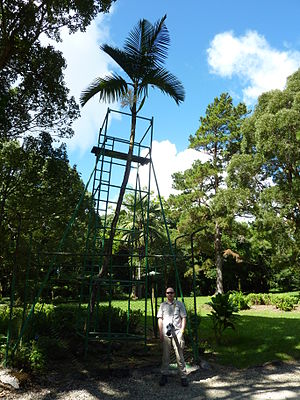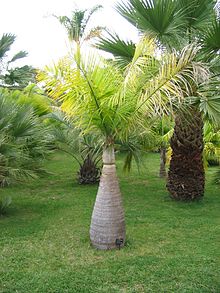Hyophore
| Hyophore | ||||||||||||
|---|---|---|---|---|---|---|---|---|---|---|---|---|

The last known specimen of Hyophorbe amaricaulis |
||||||||||||
| Systematics | ||||||||||||
|
||||||||||||
| Scientific name | ||||||||||||
| Hyophore | ||||||||||||
| Garden. |
Hyophorbe is a genus of palm that is onlynativeto the Mascarene Islands .
features
The representatives are single-stemmed, medium-sized palms with a conspicuous crown shaft and pinnate leaves. They are monoecious and flowering several times. The trunk is clearly swollen in some species and of uniform diameter in others. The trunk is covered with ring-shaped leaf scars and is gray.
The chromosome number is 2n = 32.
leaves
The leaves are pinnate. Dead leaves fall off cleanly. The leaf sheaths form a distinct crown shaft. The petiole is short, strong and furrowed on the top, rounded on the underside. The rachis is flat on the top and rounded on the underside. The leaflets are pointed to pointed, simply folded, stiff and have a distinct midrib with up to two nerves on each side. On the underside, the midrib has clear hairs (ramenta).
Inflorescences
The inflorescences are below the leaves (infrafoliar) and individually. They are three to four times branched. In the bud stage they are horn-shaped and upright. They will later be approximately horizontal. The inflorescences are protandric . The cover sheet is very short, tubular, obsolete and opens at the top. The inflorescence axis is distinct and slightly longer than the inflorescence stalk . There are usually 5 (rarely 4 to 9) decrepit bracts on the peduncle. The side branches of the first order are in a spiral arrangement, are protruding and free of branches in the lower area. The flower-bearing axes (rachillae) are slender, long and initially drooping, later protruding. The bracts of the lateral axes and rachillae are no longer present at flowering.
blossoms
The flowers are orange, yellowish or white at flowering, and sometimes fragrant. They stand in coils from a basal female and three to seven distal male flowers. Bracts of the wraps and single flowers are not available at flowering time.
The male flowers are symmetrical or slightly asymmetrical in the bud stage. The three sepals are free and imbricat , or fused at the base. The three petals are valvate and fused at the base. The six stamens have filaments that are fused together at the base and are also connected to the crown or protrude beyond the tube. Distally, the filaments are free and upright. The anthers are dorsifix, with the filaments starting at or above the center. Basally, the anthers are bifid for half or more of their length, and only briefly bifid at the tip. The opening is done latrors. The rudiment of the pistil is conical-egg-shaped and shorter than the stamens. Sometimes it is also tiny and three-lobed. The pollen is ellipsoidal, asymmetrical, sometimes flat triangular. The germ opening is a distal sulcus, rarely a trichotomosulcus. The longest axis measures 38 to 58 micrometers.
The female flowers are symmetrical and ovoid. The three sepals are free and imbricated or fused together to form a cup; the calyx tips are then slightly imbricated. The three petals are valvate or slightly imbricated, and fused at the base. The staminodes are fused at the base and form a six-lobed cup. Sometimes they carry small, abortive anthers. The gynoeceum is triple with one ovule each . There are three scars bent back to the anthesis, provided with tiny papillae . The ovary has septal nectaries . The ovules start laterally, are hemianatropic and have an aril in Hyophorbe verschaffeltii .
Fruits and seeds
The fruits are ellipsoidal to spherical or pear-shaped. They are orange to black, red or brown and usually contain a seed. They have scars in Basel, the perianth also remains on the fruit and is then thickened. The exocarp is smooth or slightly rough or covered with tiny warts. The mesocarp is thin, fleshy, interspersed with numerous reddish tannin- containing cells and with several layers of flat fibers of different widths. The endocarp is thin. The seed is egg-shaped to ellipsoidal or spherical. The hilum is small, sits basal. The nerve consists of a few simple or slightly branched strands that extend distally and laterally from the hilum. The endosperm is homogeneous. The embryo sits laterally to apically.
Distribution and locations
Hyophorbe is endemic to the Mascarene Islands . One species each occurs on Rodrigues and Réunion , three species on Mauritius and Round Island . The palm trees once covered the mountains and valleys of the Mascarene Mountains. Today all species are almost extinct in the wild. They were probably palms of the forests up to 700 m above sea level or perhaps also of the coastal savannas ( Hyophorbe lagenicaulis ). The latter species only occurs with a few individuals on exposed rocks on Round Island. The other species grow on volcanic soils or on volcanic and limestone soils ( Hyophorbe verschaffeltii ). From hyophorbe amaricaulis there is only one copy of the Botanical Garden of Curepipe on Maritius, from the other four species, there are only relatively few copies.
Systematics
The genus Hyophorbe Gaertn. is placed within the family Arecaceae in the subfamily Arecoideae , tribe Chamaedoreeae . The genus is monophyletic . The relationship of Hyophorbe within the tribe is not clear.
The Royal Botanic Gardens, Kew's World Checklist of Selected Plant Families recognizes the following species:
- Hyophorbe amaricaulis Mart. : Mauritius
- Hyophorbe indica Gaertn. : Réunion
- Bottle palm ( Hyophorbe lagenicaulis ) (LHBailey) HEMoore : Mauritius
- Hyophorbe vaughanii L.H.Bailey : It occurs in Mauritius.
- Spindle palm ( Hyophorbe verschaffeltii H. Wendl. ): Rodrigues
The generic name is derived from the ancient Greek words for pig and feed, a reference to an earlier use of the fruit as pig feed.
use
The species are used as ornamental plants and often fetch high prices in trade.
literature
- John Dransfield, Natalie W. Uhl, Conny B. Asmussen, William J. Baker, Madeline M. Harley, Carl E. Lewis: Genera Palmarum. The Evolution and Classification of Palms . Second edition, Royal Botanic Gardens, Kew 2008, ISBN 978-1-84246-182-2 , pp. 370-372.
Individual evidence
- ↑ a b c Rafaël Govaerts (Ed.): Hyophorbe. In: World Checklist of Selected Plant Families (WCSP) - The Board of Trustees of the Royal Botanic Gardens, Kew . Retrieved August 4, 2018.
